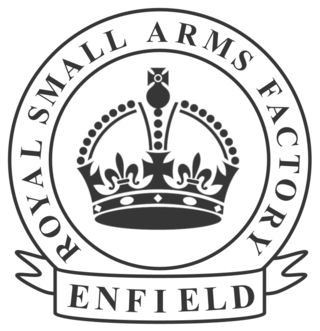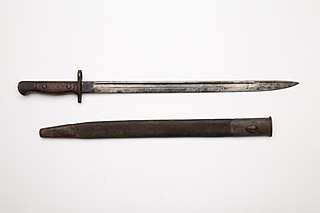
The Lee–Enfield is a bolt-action, magazine-fed repeating rifle that served as the main firearm of the military forces of the British Empire and Commonwealth during the first half of the 20th century, and was the standard service rifle of the British Armed Forces from its official adoption in 1895 until 1957.

The STEN is a British submachine gun chambered in 9×19mm which was used extensively by British and Commonwealth forces throughout World War II and during the Korean War. The Sten paired a simple design with a low production cost, facilitating mass production to meet the demand for submachine guns.

The Arisaka rifle is a family of Japanese military bolt-action service rifles, which were produced and used since approximately 1897, when it replaced the Murata rifle family, until the end of World War II in 1945. The most common models include the Type 38 chambered for the 6.5×50mmSR Type 38 cartridge, and the Type 99 chambered for the 7.7×58mm Type 99 cartridge, which is comparable in power to a modern .308 Winchester round.

The Ross rifle is a straight-pull bolt action rifle chambered in .303 British that was produced in Canada from 1903 until 1918.
The Rifle No. 5 Mk I, nicknamed the "jungle carbine" for its use in jungle warfare, was a bolt action carbine derivative of the British Lee–Enfield No. 4 Mk I. It was developed per jungle fighting experiences in the Pacific War that led the British to decide "a rifle shorter and lighter" than the regular Lee–Enfield was critical for better mobility. Produced between March 1944 and December 1947, the jungle carbine was intended for and used in jungle environments where it gained its nickname. It notably saw widespread usage on various sides of postwar colonial conflicts such as the Indonesian National Revolution, Malayan Emergency, and Vietnam War well into the 1960s, with sporadic use reported to have continued in several secessionist wars such as the Bangladesh Liberation War and Bougainville conflict throughout the rest of the 20th century.
The Lanchester is a submachine gun manufactured by the Sterling Armaments Company between 1941 and 1945. It is an evolution from MP28/II and was manufactured in two versions, Mk.1 and Mk.1*; the latter was a simplified version of the original Mk.1, with no fire selector and simplified sights. It was primarily used by the Royal Navy during the Second World War, and to a lesser extent by the Royal Air Force Regiment. It was given the general designation of Lanchester after George Lanchester, who was charged with producing the weapon at the Sterling Armaments Company.

The Webley Revolver was, in various designations, a standard issue service revolver for the armed forces of the United Kingdom, and countries of the British Empire and the Commonwealth of Nations, from 1887 to 1963.

The Martini–Henry is a breech-loading single-shot rifle with a lever action that was used by the British Army. It first entered service in 1871, eventually replacing the Snider–Enfield, a muzzle-loader converted to the cartridge system. Martini–Henry variants were used throughout the British Empire for 47 years. It combined the dropping-block action first developed by Henry O. Peabody and improved by the Swiss designer Friedrich von Martini, combined with the polygonal rifling designed by Scotsman Alexander Henry.

The Sterling submachine gun is a British submachine gun (SMG). It was tested by the British Army in 1944–1945, but did not start to replace the Sten until 1953. A successful and reliable design, it remained standard issue in the British Army until 1994, when it began to be replaced by the L85A1, a bullpup assault rifle.

The Royal Small Arms Factory (RSAF), also known by the metonym Enfield, was a UK government-owned rifle factory in Enfield, adjoining the Lee Navigation in the Lea Valley. Some parts were in Waltham Abbey. The factory produced British military rifles, muskets and swords from 1816. It closed in 1988, but some of its work was transferred to other sites.

The M1917 Enfield, the "American Enfield", formally named "United States Rifle, cal .30, Model of 1917" is an American modification and production of the .303-inch Pattern 1914 Enfield (P14) rifle, which was developed and manufactured during the period 1917–1918. Numerically, it was the main rifle used by the American Expeditionary Forces in Europe during World War I. The Danish Sirius Dog Sled Patrol in Greenland still use the M1917, which performs reliably in Arctic conditions, as their service weapon.

The Rifle, .303 Pattern 1914 was a British service rifle of the First World War period, principally manufactured under contract by companies in the United States. It was a bolt-action weapon with an integral 5-round magazine. It served as a sniper rifle and as second-line and reserve issue, until declared obsolete in 1947. The Pattern 1914 Enfield was the successor to the Pattern 1913 Enfield experimental rifle and the predecessor of the U.S. Rifle M1917 Enfield.

The origins of the modern British military rifle are within its predecessor the Brown Bess musket. While a musket was largely inaccurate over 100 yards (91 m), due to a lack of rifling and a generous tolerance to allow for muzzle-loading, it was cheap to produce and could be loaded quickly. The use of volley or mass firing by troops meant that the rate of fire took precedence over accuracy.
The Rifle 7.62mm 2A/2A1 is a 7.62×51mm NATO calibre bolt-action rifle adopted as a reserve arm by the Indian Armed Forces in 1963. The rifle is a variant of the Lee–Enfield rifle. The design of the rifle – initially the Rifle 7.62mm 2A – began at the Rifle Factory Ishapore of the Ordnance Factories Board in India, soon after the Sino-Indian War of 1962.
Lithgow Arms is an Australian small arms manufacturer located in the town of Lithgow, New South Wales. Established by the Australian Government in 1912 as the Lithgow Small Arms Factory to ease reliance on the British for the supply of defence materials, it is currently owned by Thales Australia.

The Enfield No. 2 was a British top-break revolver using the .38 S&W round manufactured from 1930 to 1957. It was the standard British/Commonwealth sidearm in the Second World War, alongside the Webley Mk IV and Smith & Wesson Victory Model revolvers chambered in the same calibre. Note that in the context of British service revolvers, the .38 S&W cartridge has often been called ".380".

The Pattern 1907 bayonet, officially called the Sword bayonet, pattern 1907 , is an out-of-production British bayonet designed to be used with the Short Magazine Lee Enfield (SMLE) rifle. The Pattern 1907 bayonet was used by the British and Commonwealth forces throughout both the First and Second World Wars.

The No. 5 bayonet was the bayonet used with the No. 5 Lee-Enfield which was nicknamed the "Jungle carbine". The bayonet was a blade which marked a return of the British Army to using blade type bayonets like the Pattern 1907 bayonet instead of socket bayonets such as the No. 4 bayonets used on the No. 4 Lee-Enfield.

The Sten bayonet Mark I was the standard bayonet for the Sten mk II submachine gun. Most of the bayonets were disposed of making originals extremely rare.
The No. 7 Bayonet was a bayonet primarily used with the Sten Mk V submachine gun. However, it could be used on the No. 4 Lee-Enfield, but only for ceremonial purposes as the bayonet obstructed the path of the .303 round fired from the gun.















